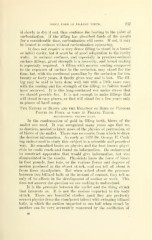Page 501 - My FlipBook
P. 501
FORCE USED IN FILLING XEETH. 237
it slowly to dry it out, then continue the heatinj? to the point of
carbonization. If the filling has absorbed fluids of the mouth
for a considerable time, carbonization will occur. If not, it may
be heated to redness without carbonization appearing.
It does not require a very dense filling to stand in a buccal
or lal)ial cavity, but it must be of good adaptation to the cavity
walls. In occlusal surfaces, and especially in proximo-occlusal
surface fillings, great strength is a necessitj^, and broad seating
is especially required. A filling with narrow seating compared
to the exposure of surface to the occlusion, may stand for the
time, but, with the continued pounding by the occlusion for ten,
twenty or forty years, it finally gives way and is lost. The fill-
ing may be said to have done well, liut with a little more care
with the seating and the strength of the filling, no failure would
have occurred. It is this long-continued use under stress that
we should provide for. It is not enough to make fillings that
will stand in easy places, or that will stand for a few years only
in places of hard usage.
The Natuee of Blows and the Belation of Sizes of Pluggeb
Points to Force as used in Filling Teeth.
ILLUSTRATIONS: FIGURES 311-319.
In the condensation of gold in filling teeth, blows of the
mallet are used. It was recognized many years ago that we,
as dentists, needed to know more of the physics of percussion, or
of blows of the mallet. There was no source from which to draw
the desired information. As early as 1870 Dr. George H. Gush-
ing endeavored to stud.y this subject in a scientific and practical
way. He consulted books on physics and the best known physi-
cists he could reach and found no information. He endeavored
to construct apparatus that would give information, but was
disappointed in the results. Physicists know the force of blows
in foot pounds, foot tons, or the various forms and degrees of
motion produced in the object struck, and can tell all about it
from these standpoints. But when asked about the pressure
between two billiard balls at the instant of contact, they tell us
only of its effects in the development of motion or work. This
does not answer the question we are seeking to understand.
It is the pressure between the mallet and the thing struck
that interests us. It is not the motion imparted to the body
struck. There are beautiful studies (and they are perfectly
correct physics from the standjDoint taken) with swinging billiard
balls, in which the motion imparted to one ball when struck by
another can be very accurately measured by the oscillation of
ss


